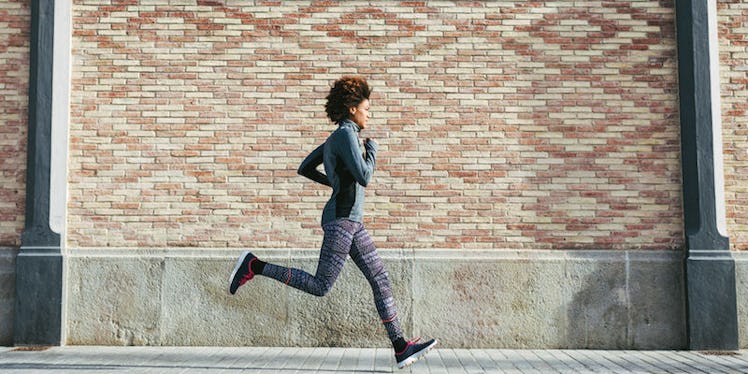In life we often strive for perfection. In athletics, however, recognizing limitations and pushing past them is the ultimate goal.
Aside from putting in the miles, a lot goes into developing your skills as a runner. You've got to buy a wardrobe (that's the fun part) and hunt down a sports bra that doesn't make your boobs resemble a bowl full of jiggling Jello. After downloading a music player or running app, the only Herculean task left is finding running shoes.
It can be a pricey, jogger-eat-jogger world out there for ladies who aren't sure what kind of athletic shoe to buy. To help break down the do's and don'ts of running shoes, we contacted Emily Carano, global product line manager of Athletic and Racing for Saucony.
With more than a decade of experience under her belt, Carano had plenty of practical tips for shoe buying and care. Whether you're a new runner or time-tested marathoner, take heed.
Take a good, long look at the runner you really are.
Every time we buy a new pair of leggings, we make lofty commitments to hit the gym more often and run 10 miles instead of three. It's important, however, to be realistic about big purchases.
"If you’re looking for a new shoe, [look] at your current shoe and how many miles you’ve put on it," Carano says. "It’s sometimes nice to not run in the same exact shoe every day just to keep your body in check, too."
Before laying down your credit card for the newest, most complex pair of sneakers, consider your everyday needs. Are you a long time jogger who will need several pairs of sneakers to mix up your routine? Do you usually hit the pavement or a dirt trail? Pick kicks that fit your routine.
Prioritize fit over price.
Hands down, the best way to ensure you're purchasing the right pair of shoes is by visiting a running store that sells multiple brands. Carano's quick to emphasize that all feet, just like fingerprints, are slightly different. For example, arches come in various heights, and foot width changes depending on the person.
She says,
[Staff will] look at your foot type. They’ll look at if you overpronate or if you just have a neutral foot. They’ll look at the width of your foot, what terrain you’re running on, how many miles you’re running, and they’ll try to find a shoe from every shoe company that is similar.
The most important point here: The shoe you need should be available by several brands and at different price points. Deciding how much money to spend on sweat-wicking tech fabrics should be the last decision you make. What you buy should always be based on budget and personal preference.
Keep your shoes dry and cool.
Now that you've found your dream shoes, it's time to take them for a spin. According to Carano, you shouldn't have to bring Band-Aids along to your first run in anticipation of blisters. Today's running sneakers use smart fabrics, so the break-in period won't last for days. You should be able to run immediately.
Once you've wrapped up that last, sweaty mile, your mind should turn towards taking care of your shoes. After sliding your shoes off, allow them "to breathe" in an open-air space, instead of just stuffing them into your gym bag. If they're damp from rain or perspiration, Carano recommends stuffing them with newspaper overnight to soak up any extra moisture.
Don't forget to keep an eye on the temperature as well. Carano emphasizes heat, like the kind from closed cars, can cause your shoes' plastic elements to lose shape.
Know when it's time to say goodbye.
Just when you've fallen in love with running in your new shoes, it seems as if they no longer give you the spring they once did.
While it may be hard to tell, Carano offers up a fairly universal measure of the lifespan of a running shoe.
She says,
If you’re looking for a new shoe, typically they last three to five hundred miles. That’s kind of what our gauge is.
Aside from miles ran, a good way to measure a "dead" shoe is by examining its cushioning as well as your own body's reaction to the run. If the cushioning is mostly compressed, for example, you may feel an increased soreness in your knees after a lengthy jog.
The good news is once you've been fitted, you're free to shop online. Many athletics stores allow product filtering by width and terrain. This digital tool will help you find a specialized shoe.
New shoes = more happy trails.
